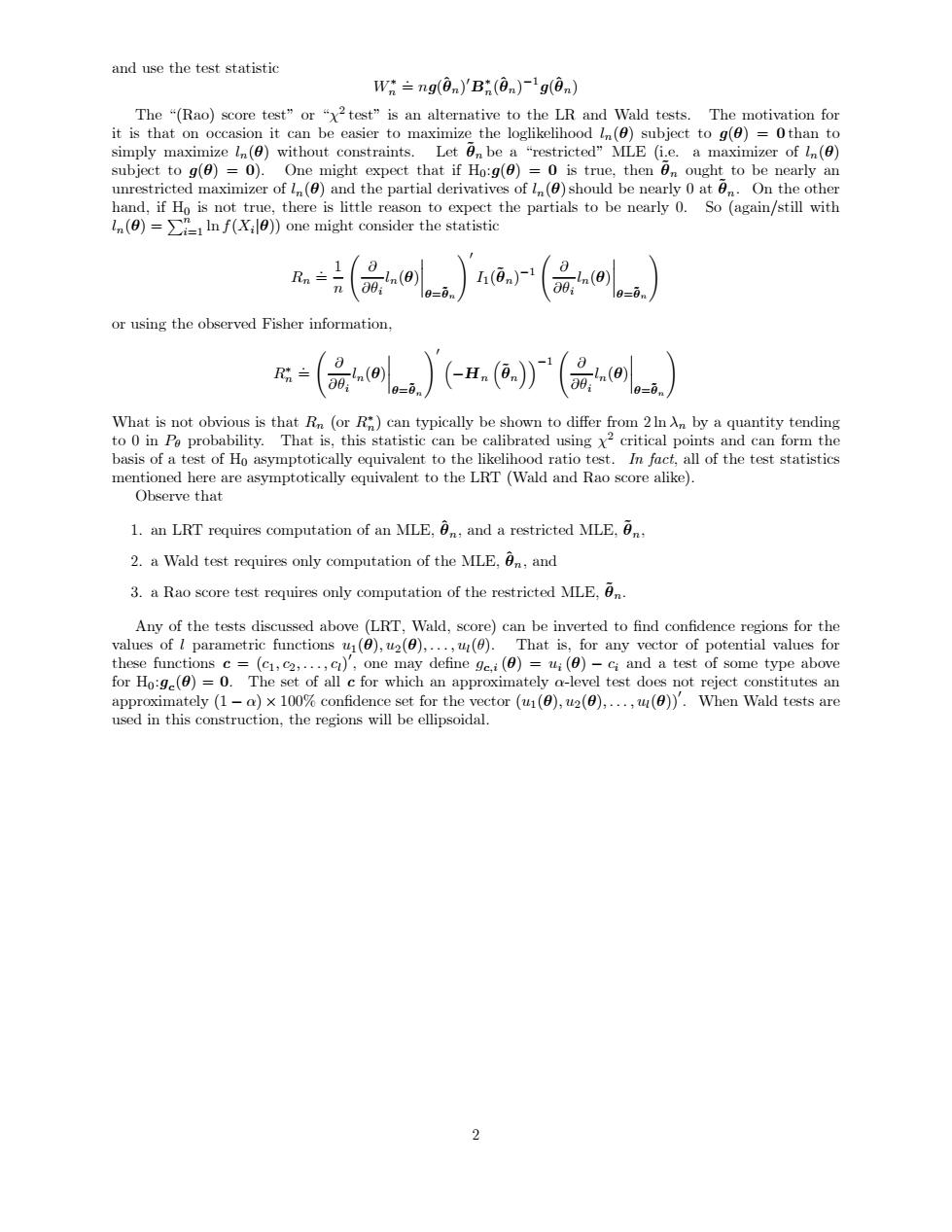正在加载图片...

and use the test statistic Wi =ng(on)'Bi(on)-1g(on) The "(Rao)score test"or "x2test"is an alternative to the LR and Wald tests.The motivation for it is that on occasion it can be easier to maximize the loglikelihood In()subject to g(0)=0than to simply maximize In(0)without constraints.Let On be a "restricted"MLE (i.e.a maximizer of In(0) subject to g()=0).One might expect that if Ho:g()=0 is true,then On ought to be nearly an unrestricted maximizer of l(0)and the partial derivatives of In()should be nearly 0 at en.On the other hand,if Ho is not true,there is little reason to expect the partials to be nearly 0.So (again/still with ()In f())one might consider the statistic or using the observed Fisher information. Rn= (品aol)(a》'(0la) What is not obvious is that Rn (or R)can typically be shown to differ from 2In An by a quantity tending to 0 in Po probability.That is,this statistic can be calibrated using x2 critical points and can form the basis of a test of Ho asymptotically equivalent to the likelihood ratio test.In fact,all of the test statistics mentioned here are asymptotically equivalent to the LRT (Wald and Rao score alike). Observe that 1.an LRT requires computation of an MLE,0n,and a restricted MLE,, 2.a Wald test requires only computation of the MLE,On,and 3.a Rao score test requires only computation of the restricted MLE,On. Any of the tests discussed above (LRT,Wald,score)can be inverted to find confidence regions for the values of l parametric functions u(),u2(),...,u().That is,for any vector of potential values for these functions c=(c1,c2,...,c),one may define ge.i()=ui(0)-ci and a test of some type above for Ho:g(0)=0.The set of all c for which an approximately a-level test does not reject constitutes an approximately (1-a)x 100%confidence set for the vector (u1(0),u2(0),...,u())'.When Wald tests are used in this construction,the regions will be ellipsoidal. 2and use the test statistic W∗ n . = ng(θ ˆn) 0 B∗ n(θ ˆn) −1g(θ ˆn) The “(Rao) score test” or “χ2 test” is an alternative to the LR and Wald tests. The motivation for it is that on occasion it can be easier to maximize the loglikelihood ln(θ) subject to g(θ) = 0 than to simply maximize ln(θ) without constraints. Let θ ˜n be a “restricted” MLE (i.e. a maximizer of ln(θ) subject to g(θ) = 0). One might expect that if H0:g(θ) = 0 is true, then θ ˜n ought to be nearly an unrestricted maximizer of ln(θ) and the partial derivatives of ln(θ)should be nearly 0 at θ ˜n. On the other hand, if H0 is not true, there is little reason to expect the partials to be nearly 0. So (again/still with ln(θ) = Pn i=1 ln f(Xi|θ)) one might consider the statistic Rn . = 1 n à ∂ ∂θi ln(θ) ¯ ¯ ¯ ¯ θ=θ ˜n !0 I1(θ ˜n) −1 à ∂ ∂θi ln(θ) ¯ ¯ ¯ ¯ θ=θ ˜n ! or using the observed Fisher information, R∗ n . = à ∂ ∂θi ln(θ) ¯ ¯ ¯ ¯ θ=θ ˜n !0 ³ −Hn ³ θ ˜n ´´−1 à ∂ ∂θi ln(θ) ¯ ¯ ¯ ¯ θ=θ ˜n ! What is not obvious is that Rn (or R∗ n) can typically be shown to differ from 2 ln λn by a quantity tending to 0 in Pθ probability. That is, this statistic can be calibrated using χ2 critical points and can form the basis of a test of H0 asymptotically equivalent to the likelihood ratio test. In fact, all of the test statistics mentioned here are asymptotically equivalent to the LRT (Wald and Rao score alike). Observe that 1. an LRT requires computation of an MLE, θ ˆn, and a restricted MLE, θ ˜n, 2. a Wald test requires only computation of the MLE, θ ˆn, and 3. a Rao score test requires only computation of the restricted MLE, θ ˜n. Any of the tests discussed above (LRT, Wald, score) can be inverted to find confidence regions for the values of l parametric functions u1(θ), u2(θ),...,ul(θ). That is, for any vector of potential values for these functions c = (c1, c2,...,cl) 0 , one may define gc,i (θ) = ui (θ) − ci and a test of some type above for H0:gc(θ) = 0. The set of all c for which an approximately α-level test does not reject constitutes an approximately (1 − α) × 100% confidence set for the vector (u1(θ), u2(θ),...,ul(θ))0 . When Wald tests are used in this construction, the regions will be ellipsoidal. 2